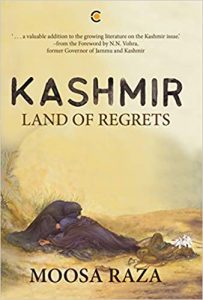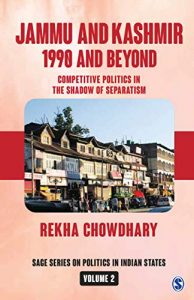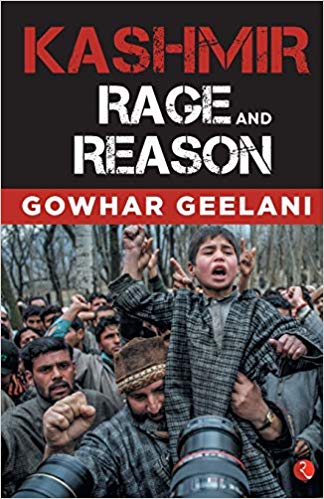Personalized accounts are a powerful source of knowledge about intricacies of conflict, and violence that follows. Rather than relying on grand theories or narratives, these accounts navigate a reader through the ‘lived and survived experiences’ of violence/conflict. Gowhar Geelani’s book is an attempt to narrate the conflict from the perspective of a person who like most other Kashmiris bears witness to violence unleashed upon them from all sides, and who like many other people has lost loved ones during the last few decades.
There has been a massive shift in the politics of Kashmir after the 1990s as violence engulfed the whole region. The state has been very ruthless, and the media mindless. The young in Kashmir are fighting this ruthlessness and mindlessness. According to Geelani, this book is an answer to those who ask why there is so much anger in Kashmir.
Geelani steers you through many of the recent phenomena in Kashmir. The book starts with Burhan, his popularity and acceptance as a militant leader throughout the Valley. During his visit to Tral, the hotbed of militancy today, Gowhar tries to uncover the reasons for popular support to the so called ‘New Age Militants/Militancy’. While discussing the struggle in Kashmir, the author argues that it is political rather than religious in nature. The increasing religious overtures of the militancy and protests are a reaction to increasing Hinduism in mainland India. He adds that different identities and nationalisms have shaped the political landscape of Kashmir since 1947. He also talks about possibilities of peace and lost opportunities in the Valley. ‘Militant-resistance leaders’ had shown willingness to engage in talks but all such attempts proved futile. Not only the leadership but the people had also shown interest in the peace process and shifted from violent to nonviolent forms of resistance. The Indian state responded to this gesture of peace with highhandedness and violence which led to the renewal of militancy in Kashmir. Apart from militancy, creative forms of resistance also are part of the protest culture in Kashmir; these include graffiti, theatre, music, poetry, sit-ins and much more.
 The author talks about the brutality of the security forces and militants/unknown assailants and also makes a passionate appeal for the return of Kashmiri Pandits. Geelani laments the state of journalists and media houses in India, and describes ‘them’ as a jingoistic-chauvinistic-prejudiced-and ill-informed Indian propagandist media machinery.
The author talks about the brutality of the security forces and militants/unknown assailants and also makes a passionate appeal for the return of Kashmiri Pandits. Geelani laments the state of journalists and media houses in India, and describes ‘them’ as a jingoistic-chauvinistic-prejudiced-and ill-informed Indian propagandist media machinery.
The penultimate chapter looks at possible solutions to the Kashmir problem and hurdles thereof, and the last one blames the ‘failed and unwilling’ leadership in India, Pakistan and Kashmir for the current mess in the Valley. The book questions and challenges the working of the state and other non-state actors in a conflict zone.
There are breaks in the flow of arguments at many places in the book. There is a lot of repetitive arguments in many chapters. At certain places the personal experiences of the author seem to be exaggerated and the narrative looks like an attempt at self-vindication (p. 128). Apart from a few personal experiences and informal/formal conversations with people, the book is a collection of newspaper stories of the past many years. The author also fails to recognize that ‘creative forms of resistance’ are actually ‘borrowed or cooler forms of resistance’, which the Kashmiris borrowed from the rest of the world. It has been done at the cost of indigenous forms of resistance like ‘Ladi Shah’ (a form of folk art in which a minstrel narrates on a social/political issue through singing in sync with a local musical instrument) and ‘Paether’ (folk-theatre). The last chapter reads like a travelogue. I will end by saying that the book fails its title and is run-of-the-mill.
 The book by Moosa Raza, a retired IAS officer, is an addition to the corpus of literature on Jammu and Kashmir (J&K). The book is a partial memoir based on written notes made by the author during his tenure as Chief Secretary in J&K in the late 1980s. During his initial days in J&K, the author witnesses factionalism in the bureaucracy, corrupt politicians and Shia-Sunni dissension within society. In this sea of fraudulence, according to Raza, one of the few persons whose integrity cannot be questioned is Dr. Farooq Abdullah.
The book by Moosa Raza, a retired IAS officer, is an addition to the corpus of literature on Jammu and Kashmir (J&K). The book is a partial memoir based on written notes made by the author during his tenure as Chief Secretary in J&K in the late 1980s. During his initial days in J&K, the author witnesses factionalism in the bureaucracy, corrupt politicians and Shia-Sunni dissension within society. In this sea of fraudulence, according to Raza, one of the few persons whose integrity cannot be questioned is Dr. Farooq Abdullah.
The author then delves deep into the history of Kashmir and argues that for centuries people were treated worse than animals by different rulers which has led to resentment and suspicion among the masses against all ruling dispensations. Raza mentions the problems faced by Kashmiris during the winter season, especially shortage of meat and electricity and unavailability of elected representatives. He decries the sorry state of forests and environment in the State and argues that Kashmiris are not environmentally conscious and are responsible for ruin of this resource.
During his tenure, the author proposed the employment of 3000 youth to the Central Reserve Police Force (CRPF) in order to the stop youth from indulging in timber smuggling and joining militancy. This argument is not very sound because the reasons for militancy were varied and complex. The author travels extensively through the length and breadth of Kashmir and makes his reader aware of the problems faced by the populace in distant places, and also about measures he took during his tenure to ensure that all problems faced by people were resolved on time. Raza talks about Wazwan, Ziarats (Sufi Shrines) of the Kashmir and argues that Sufism had a great influence in shaping Kashmir society. He also touches upon the initial years of militancy in J&K and the major crises that followed like the death of the father of Shabir Shah and the ensuing Anantnag crises, Chota Bazar Midnight Cordon and Search Operation (CASO) and Rubaiya Sayeed kidnapping. During these crises, Raza never lost his cool, dealt with each situation like a rock; went beyond the enemy lines, many times to negotiate a deal, that too despite reservations by other officials in government. Overall, the author portrays himself as messiah of honesty, integrity, development and righteousness.
Raza says that after Governor Krishna Rao tended his resignation, Farooq Abdullah was apprehensive that Jagmohan will be anointed, and in that case, he would tend his resignation. Despite the reservations of Raza and Farooq, the Centre persisted in Jagmohan’s appointment. This was because of the enmity between Mufti Sayeed, the then Home Minister, and Farooq. The resignation of Farooq led to the worsening of an already bad situation as the State came under the direct rule of the Governor. The author names four villains for all the mess in J&K: Lord Mountbatten, Maharaja Hari Singh, Mohammad Ali Jinnah and Jawaharlal Nehru.
The chapters of the book do not follow a proper sequence. While the author remembers a lot of things precisely, he has remained silent on his departure from J&K. Apart from his personal experiences in Kashmir, the main argument of the book is that the Government of India (GoI), since 1947, has done many wrongs in the State of Jammu and Kashmir. In Kashmir, GoI has violated all fundamentals/ideals on which the Indian Constitution/nation stands. The approach that J&K is an integral part of India is visible, and there is also a paternalistic-civil servant attitude which vouches for fulfilment of the basic needs of the subject population at the cost of their political aspirations. The colonial-imperialist arrogance is also manifest in the book as the author has used words like ‘dirty pheran(s)’ (pp. 44, 67), ‘environmentally insensitive Kashmiris’ (pp. 67), ‘lacked any sense of civility’ (p.44) to stereotype a particular population. Raza has taken a moral high ground.The book adds nothing to the burgeoning literature on J&K.
After publishing many articles on the theme of ‘Separatist and Democratic Politics’ in Jammu and Kashmir (J&K), Rekha Chowdhary has finally come up with a more detailed analysis of the issue through this book. Kashmir is not the only focus of the book, rather the author ricochets on the politics of Jammu and Ladakh regions, and also the ensuing tensions between the three. In the first two chapters-–‘The Background to the State Politics of Jammu and Kashmir: The Context of Conflict’ and ‘State of Jammu and Kashmir: Internal Complexity’, the author digs into the history of the conflict in J&K and the diversity within. Rekha adds that conflict has been instrumental in deciding the intrastate politics, inter-regional, intra-regional and federal relations, institution building and every other aspect of life in J&K (p.10). The main argument of the second chapter is that beyond Kashmiri identity politics, which is central to the Kashmir conflict, ‘there are competing identities which operate in parallel and opposite directions’ in all three regions of the State (p. 42). She then analyses these ‘competing inter-regional and intra-regional identities’, and how they shape the politics of each region and J&K also. Chowdhary further adds that the primacy of the Kashmir conflict has eclipsed other socio-economic movements in the State which mostly concern the marginalized sections of the society. For example, women’s and Dalit politics have been submerged in competing identity politics of their respective regions.
In the next chapter, ‘Politics of Separatism: 1989-2010’, the author argues that separatism had many faces; post-1989 it can be divided into three: a) militant phase b) post-militant phase and c) recent phase of separatism. The initial phase of separatism in the form of militancy had wider acceptance and legitimacy and it started to wane with the coming of foreign militants, and also due to the role of moderates. In its recent phase i.e., 2008 and after, separatism in the form of militancy is getting a new lease of life and popular support. Chowdhary then briefly delves into ‘The Exodus of Kashmiri Pandits’ and argues that there are two conflicting and contradictory narratives which describe Pandit migration. In her view none of the two views are gospel truth, the reality is much more layered and complex.
The 1996 assembly election was a step towards the restoration of ‘democratic space’ in the State, despite cases of militant violence and charges of coercion by security forces. The National Conference (NC) had a role to play in this restoration regardless of the fact that it had lost its past sheen. The NC re-established its ground network and contact with people. The ‘democratic space’ was concretized by the 2002 assembly elections with the coming of the People’s Democratic Party (PDP) on the electoral platform. The decline of militancy and PDP’s use of soft separatism also entrenched this democratic space. In the next chapter, ‘Competitive Politics in Jammu and Kashmir’, the author discusses communalization and fragmentation of electoral politics in J&K, decline of NC hegemony and emergence of PDP as its main contender, and also looks at the rise of the BJP in the State.
According to the author, governance in the State became the victim of conflict. The State leaders were corrupt from the beginning and this corruption was tolerated by the central leaders for the sake of national interest. Post-1996, the State Government started building infrastructure which was destroyed during the peak of militancy. Governance occupied centre stage only after the 2002 assembly elections under the duress of coalition politics. The local politicians were careful not to intermingle the two spheres of ‘governance’ and ‘separatism’. She adds that institutions of the State are not well developed to cope with the growing demands of society, and Panchayati Raj has suffered due to Article 370 and unwillingness of local politicians to devolve powers to local level.
‘Interregional Relations and Politics of Jammu and Ladakh Since 1990’ talks about interregional relations and politics in the regions of Jammu and Ladakh in detail. In the concluding chapter, ‘Democracy and Politics of Separatism in Kashmir: 2014 and After’ Chowdhary argues that the 2014 Assembly elections saw the same fragmented verdict but this time, two ideologically opposite parties got popular mandate in the two regions of Kashmir and Jammu. The government was formed with focus on a common agenda but there were inherent tensions within this so called ‘unholy’ alliance which ultimately led to the breaking away of coalition partners. Post 2016 saw huge protests in the Valley and there was resurgence of legitimacy of militancy. The militants who are mostly local have greater acceptability now.
The main argument of the book is that ‘separatist politics’ and ‘democratic politics’ operate according to their own logic in the State, they run parallel to each other and sometimes overlap. The ‘democratic space’ of the State is not affected by violence or militarization, rather by the popular response to ‘separatist politics’.
There is some repetition in the book and the chapter on governance has used Planning Commission data from 2003 which is almost 15 years old. Elections, specifically post-1996, remain one of the understudied areas in J&K, and this book fills that lacuna.
Waqas Farooq Kuttay is a PhD candidate at the Department of Political Science, Jamia Millia Islamia, New Delhi.
[/ihc-hide-content]

